Recipes
How To Thicken Mashed Potatoes [7 Easy Methods]
![How To Thicken Mashed Potatoes [7 Easy Methods]](https://www.instacart.com/company/wp-content/uploads/2023/12/how-to-thicken-mashed-potatoes-hero.jpg)
It’s no secret that mashed potatoes are a staple side dish for traditional dinners, holiday celebrations and even comfort food. But what happens when you add too much liquid and you’re racing the clock to get dinner on the table? Don’t feel bad; it happens to the best of us!
Try one of the seven methods below to learn how to thicken mashed potatoes like a pro and save your side dish. No one will even think you ran into any obstacles along the way.
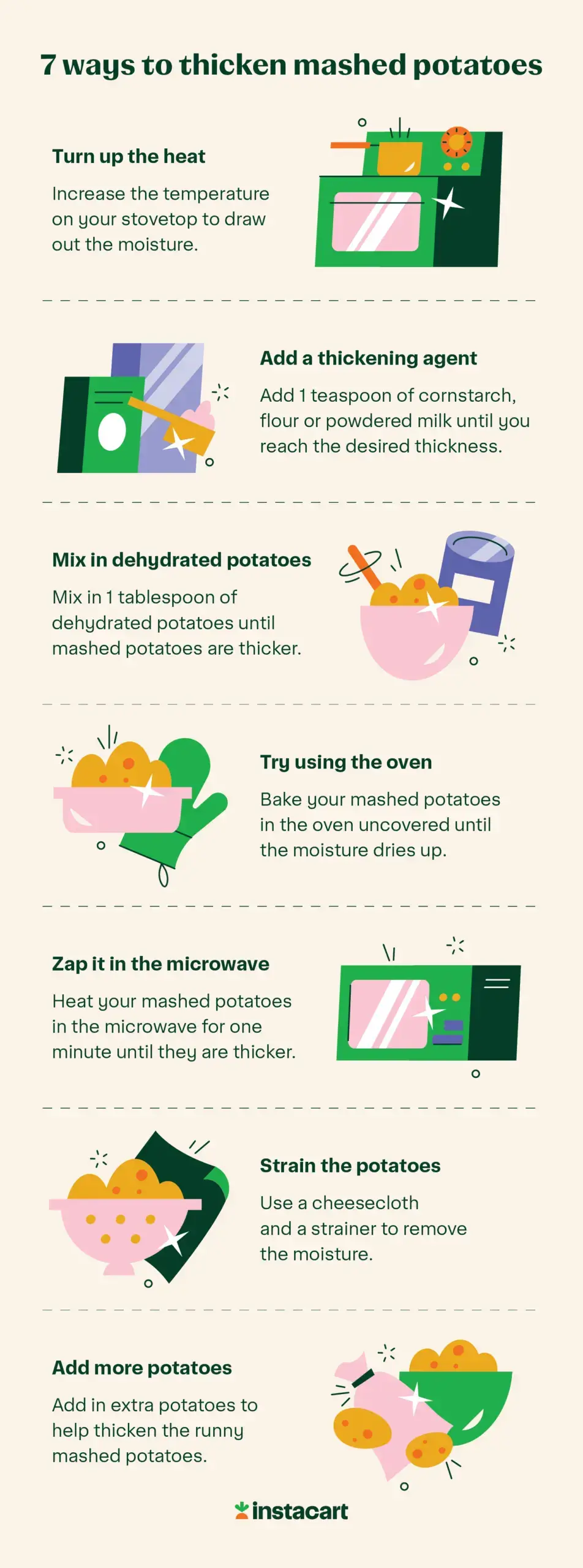
1. Turn up the heat
If you’re unsure how to thicken mashed potatoes, you can try the simple method of turning up the heat on the stovetop. Slightly increase the temperature on your stove and cook your potatoes with the lid off — this helps draw out more moisture from runny mashed potatoes. Make sure to stir every minute or so, but don’t overwork the potatoes, which can cause them to become sticky or gummy.
Increasing the temperature helps the liquid evaporate and compounds the mixture. This method also works if you need to thicken sauces.
2. Add a thickening agent
Flour, cornstarch and even powdered milk can thicken mashed potatoes quickly. Gradually stir a teaspoon of one of these commonly found thickening agents into your mashed potatoes until you reach the desired thickness — start with a teaspoon, and you can always add more if needed. While you can use any thickening agent, we recommend cornstarch, which is gluten-free and doesn’t alter the taste.
3. Mix in dehydrated potatoes
If you have dehydrated potatoes in your pantry or cabinets, you can use them if you’re unsure how to thicken mashed potatoes. Stir in 1 tablespoon of the instant potato flakes until your mixture reaches the desired consistency. While they can slightly alter the taste, they work wonders if you’re in a pinch.
4. Try using the oven
Just like the stovetop, an oven set at 300 degrees Fahrenheit, is another option to thicken mashed potatoes quickly. Add your mashed potatoes to a baking dish and cook them for five to 10 minutes, depending on how long it takes for the moisture to dry up. Make sure to leave your baking dish uncovered so the moisture isn’t trapped.
5. Zap it in the microwave
A quick way to add more thickness to watery mashed potatoes is the microwave. Place your potatoes in a microwave-safe container and cook them on high for one minute. Stir and check the thickness of the potatoes. If they still have moisture, cook them for an additional minute. Continue this process until your potatoes have a smooth consistency that isn’t runny.
6. Strain the potatoes
You can reduce excess moisture in runny potatoes by straining them using a cheesecloth or a strainer. Add your potatoes to a cheesecloth after they cool down and form them into a ball, then gently squeeze it to get rid of the moisture. Leave your potatoes to continue the draining process for up to an hour — check periodically.
7. Add more potatoes
Did you save some potatoes for a rainy day? Cook the last batch of potatoes you have lying around to add to your runny mashed potatoes. Combine both batches of mashed potatoes in a saucepan on the stovetop. The heat will help the potatoes blend together to create perfectly thick mashed potatoes.
How to get a smooth potato consistency
While there’s no right or wrong consistency, as some folks enjoy mashed potatoes with lumps, you can follow these steps to make smooth and creamy mashed potatoes every time.
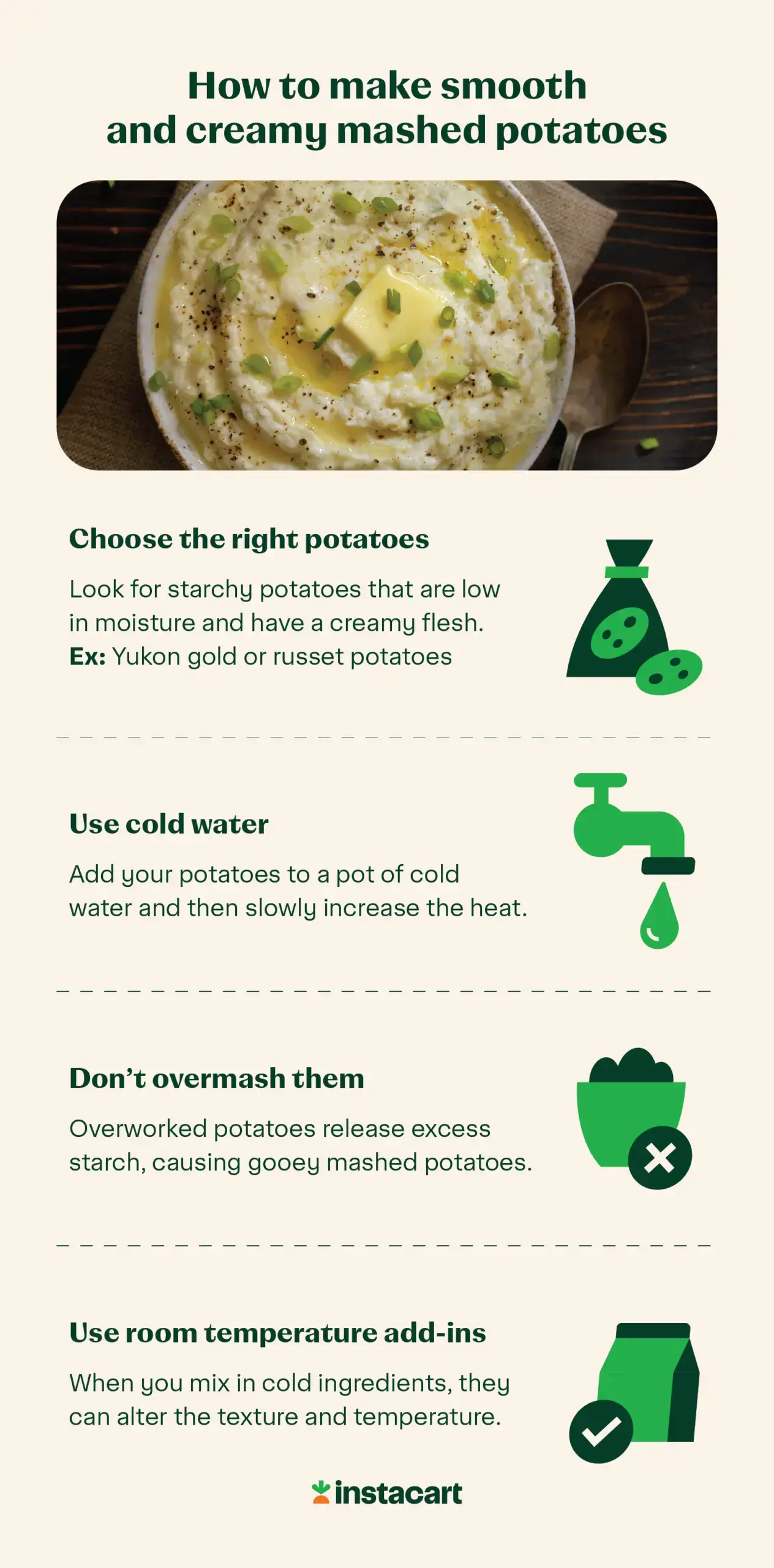
Choose the right potatoes
The first step is to choose starchy potatoes (low in moisture with creamy flesh), which transform into a soft, fluffy consistency when cooked. Yukon gold potatoes or russet potatoes work well. Red-skinned and fingerling potatoes aren’t good options because they don’t absorb much liquid and can lead to a gummy texture.
Use cold water
Make sure you aren’t adding your potatoes to boiling or hot water because the outside will cook faster, causing an uneven level of doneness. Instead, add your potatoes to a pot of cold water and then slowly increase the heat. Once your water starts to boil, turn down the temperature to simmer — this helps the potatoes keep their shape and maintain the perfect consistency.
Don’t overmash your potatoes
It’s easy to overwork your potatoes during the mashing process. You can use a mixer, blender, food processor or any other electric mixing tool if you’re in a pinch. Or you can use a potato masher and manually mix them.
Mastering the technique will require practice and patience. In the meantime, try to reduce your speed and avoid vigorous mixing. Overworked potatoes release excess starch, causing gooey mashed potatoes.
Use room temperature add-ins
If you’re adding any liquids to your smooth and creamy mashed potatoes, make sure they’re warm or room temperature. When you mix in cold ingredients, they can alter the texture and temperature of the potatoes. Make sure to add the ingredients gradually so you don’t end up with runny mashed potatoes.
How to fix runny mashed potatoes
Runny mashed potatoes can happen to the best of us, but they’re easy to fix. Whether you’ve added too much liquid or the potatoes are too soft, there are simple steps to bring them back to the perfect creamy consistency.
- Heat them up: Place the mashed potatoes back on the stove over low heat, stirring continuously to evaporate excess moisture.
- Add thickening agents: Mix in more starch by adding instant potato flakes, cornstarch or flour in small amounts until the texture firms up.
- Strain excess liquid: If your mashed potatoes are watery, strain off any liquid by placing them in a colander for a few minutes.
- Incorporate more potatoes: Boil a few extra potatoes, mash them and fold them into the mixture to absorb excess moisture.
- Bake them: Transfer the mashed potatoes to an oven-safe dish and bake at 350°F for 10-15 minutes to thicken them up.
Mashed potato recipes

Looking to spice up your mashed potatoes? Check out these mashed potato recipes to find your next favorite method.
- Creamy mashed potatoes
- Creamy garlic mashed potatoes
- Black pepper and blue cheese mashed potatoes
- Cheddar, scallion and bacon mashed potatoes
- Chive and buttermilk mashed potatoes
- Garlic and chive mashed potatoes
- Instant Pot mashed potatoes
- Roasted garlic mashed purple potatoes
- Rustic garlic mashed potatoes
Grab it now on Instacart:
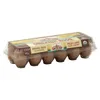


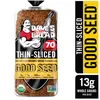


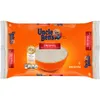



How to thicken mashed potatoes FAQ
When it comes to achieving the perfect mashed potatoes, consistency is key. Below, we address common questions about thickening mashed potatoes, helping you fix any issues and achieve a creamy, delicious result.
To fix the consistency of mashed potatoes, start by heating them gently on the stove to allow excess moisture to evaporate. You can also add thickening agents like instant potato flakes or cornstarch gradually until you reach the desired texture. If they’re too thick, a splash of milk or cream can help loosen them up.
Yes, sour cream can help thicken mashed potatoes while adding a rich, tangy flavor. When mixed in, it contributes both creaminess and thickness, making it a great option for achieving the perfect consistency. Just be mindful of the amount; start with a few tablespoons and adjust to taste.
Watery mashed potatoes often result from using too much liquid during preparation or overcooking the potatoes, which causes them to lose their starch. To prevent this, it’s best to add liquids gradually and stop once the desired consistency is reached.
You’ll know your mashed potatoes are thick enough when they hold their shape and don’t run off a spoon. They should have a creamy, smooth texture that can be easily spread but still retain some body.
Through thick and thin — get your potatoes delivered
Now that you know how to thicken mashed potatoes, why complicate the shopping process with last-minute stops at the grocery store? Whether you need a thickening agent like cornstarch or an extra batch of potatoes to mix into your runny mashed potatoes, Instacart has you covered. Place an order today and receive everything you need right to your door.
Need more food ideas? Check out these comfort food dinner recipes to soothe your soul. Looking to spice up your holiday dinner? Order Thanksgiving dinners through Instacart.
How to thicken mashed potatoes
Course: RecipesCuisine: AmericanDifficulty: EasyIncreasing the heat, using a thickening agent or straining your potatoes are a few ideas if you’re unsure how to thicken mashed potatoes.
Ingredients
Runny mashed potatoes
Cornstarch, flour or powdered milk
Cheesecloth
Strainer
Dehydrated potatoes
Extra potatoes
Directions
- Option 1: Turn up the heat on your stovetop to draw out the moisture.
- Option 2: Add a teaspoon of a thickening agent like cornstarch, flour or powdered milk until you reach the desired thickness.
- Option 3: Mix in 1 tablespoon of dehydrated potatoes until mashed potatoes are thicker.
- Option 4: Bake your mashed potatoes in the oven uncovered until the moisture dries up.
- Option 5: Zap your mashed potatoes in the microwave for one minute until they are thicker.
- Option 6: Use a cheesecloth and strainer to remove the moisture.
- Option 7: Add in extra potatoes to help thicken the runny mashed potatoes.
Most Recent in Recipes
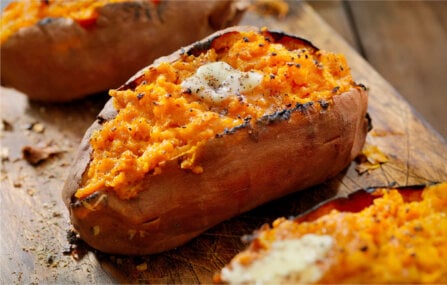
Recipes
How Long To Bake Sweet Potatoes in the Oven: Recipes, Tips & More
Are you on sweet potato duty this holiday season? No need to worry! If you haven’t prepared them before, you may be wondering how long to bake a sweet potato. Fortunately, we’ve got the answers…
Dec 23, 2024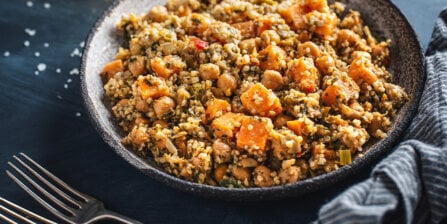
Recipes
How To Cook Quinoa Perfectly: Easy Tips and Recipe Ideas
Cooking quinoa can feel a bit intimidating at first, but with a few tips and tricks, you’ll have perfectly fluffy quinoa ready to add to your favorite dishes. Whether you’re new to quinoa or simply…
Dec 19, 2024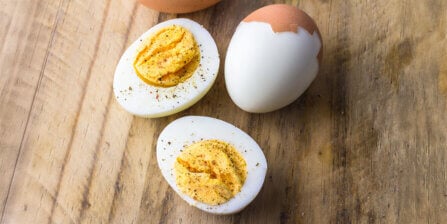
Recipes
How To Boil Eggs for the Perfect Bite in 5 Steps
Boiling eggs might seem simple, but achieving that perfect bite — whether it's a soft, creamy yolk or a firm, golden center — can be a challenge. If you've ever searched for how to boil…
Dec 19, 2024
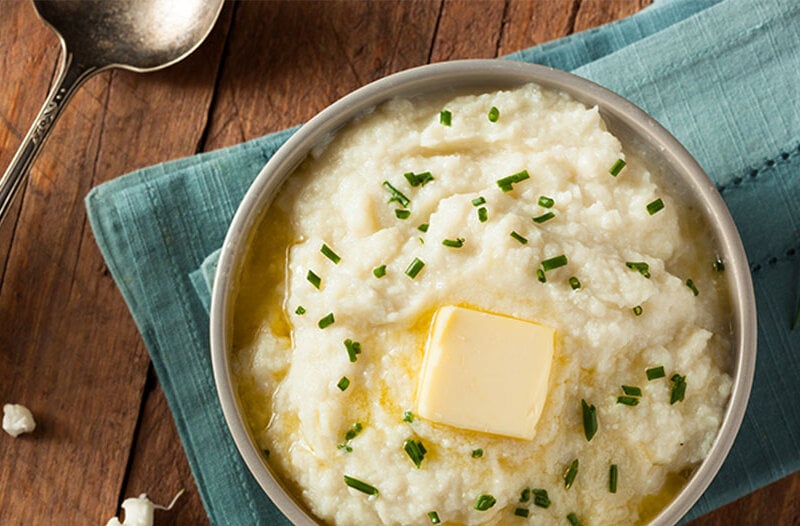


 A Crowd Pleasing Salsa Roja – Recipe Ideas From The Instacart Team
A Crowd Pleasing Salsa Roja – Recipe Ideas From The Instacart Team  “Old Smokeshow” Cocktail – Recipe Ideas From The Instacart Team
“Old Smokeshow” Cocktail – Recipe Ideas From The Instacart Team  A Light Greek Salad – Recipe Ideas From The Instacart Team
A Light Greek Salad – Recipe Ideas From The Instacart Team 

